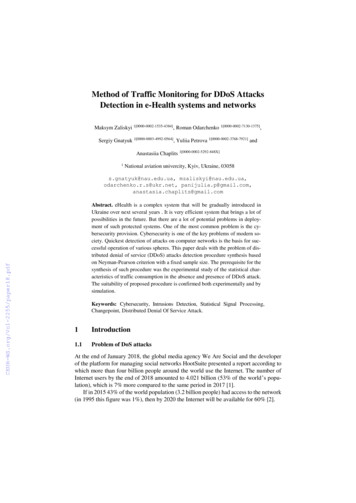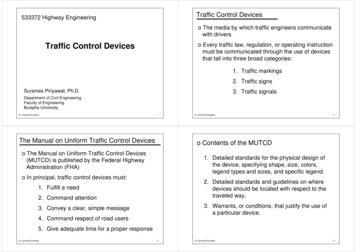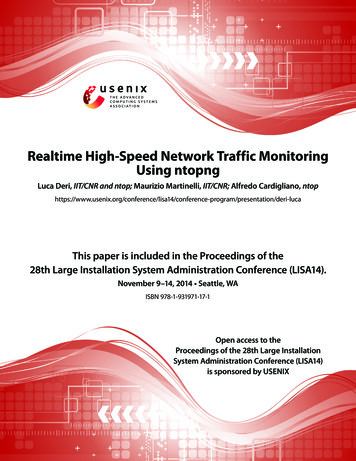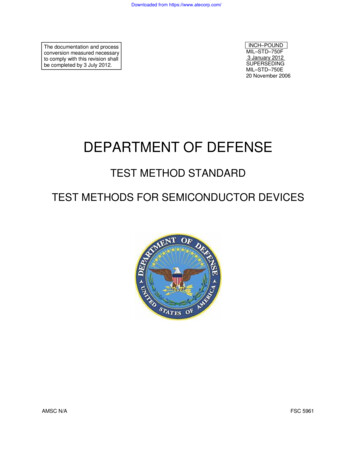
Transcription
Method of Traffic Monitoring for DDoS AttacksDetection in e-Health systems and networksMaksym Zaliskyi 1[0000-0002-1535-4384], Roman Odarchenko 1[0000-0002-7130-1375],Sergiy Gnatyuk 1[0000-0003-4992-0564], Yuliia Petrova 1[0000-0002-3768-7921] andAnastasiia Chaplits 1[0000-0002-5292-848X]1National aviation univercity, Kyiv, Ukraine, 03058s.gnatyuk@nau.edu.ua, mzaliskyi@nau.edu.ua,odarchenko.r.s@ukr.net, Abstract. eHealth is a complex system that will be gradually introduced inUkraine over next several years . It is very efficient system that brings a lot ofpossibilities in the future. But there are a lot of potential problems in deployment of such protected systems. One of the most common problem is the cybersecurity provision. Cybersecurity is one of the key problems of modern society. Quickest detection of attacks on computer networks is the basis for successful operation of various spheres. This paper deals with the problem of distributed denial of service (DDoS) attacks detection procedure synthesis basedon Neyman-Pearson criterion with a fixed sample size. The prerequisite for thesynthesis of such procedure was the experimental study of the statistical characteristics of traffic consumption in the absence and presence of DDoS attack.The suitability of proposed procedure is confirmed both experimentally and bysimulation.Keywords: Cybersecurity, Intrusions Detection, Statistical Signal Processing,Changepoint, Distributed Denial Of Service Attack.1Introduction1.1Problem of DoS attacksAt the end of January 2018, the global media agency We Are Social and the developerof the platform for managing social networks HootSuite presented a report according towhich more than four billion people around the world use the Internet. The number ofInternet users by the end of 2018 amounted to 4.021 billion (53% of the world’s population), which is 7% more compared to the same period in 2017 [1].If in 2015 43% of the world population (3.2 billion people) had access to the network(in 1995 this figure was 1%), then by 2020 the Internet will be available for 60% [2].
2The number of sensors and devices connected to the Internet of Things in the worldin 2018 will be 21 billion, and by 2022 will exceed 50 billion, according to a study byJuniper Research [3].At the same time, the global network is becoming increasingly dangerous, as it becomes more and more easier to organize all categories of cyberattacks on the most popular resources as well as on critical infrastructure. One of the most common attacks isthreat realization directed to the denial of service (Denial of Service, DoS) [4].The most common methods of DoS attacks are SYN-DDoS, TCP-DDoS, HTTPDDoS. Also popular attacks are strong UDP attacks with amplification, which came intouse a few years ago, but still remain relevant due to the ease of implementation, and theability to provide tremendous power.They are increasingly organized to block the operation of individual sites and entireinformation systems. With the increasing the number of devices connected to the Internetnetwork (IoE concept – Internet of everything [5]), the threat from distributed DoS attacks (DDoS) is growing. They arise from the bot-nets – networks that consist of infecteddevices that are able to generate queries aimed at exhausting the resources of networkdevices or entire information networks.The point of the DDoS attack is that there is a scarce resource in the victim’s networkinfrastructure, the depletion of which causes a denial of service.The most well-known recent attacks were aimed at exhausting the bandwidth of thesite’s connection to the Internet.However, the development of broadband access technologies and cloud computingcomplicate this task. But, to all appearances, the intruders are not intimidated by thedifficulties, and they are trying to organize more and more powerful attacks. In thespring of this year, the infrastructure of one cloud provider was attacked with a capacityof 400 Gbit / s, but more large-scale shares are possible as well [6]. In these conditionsfor providers, owners of information systems and simple users, it is important to determine the occurrence of the above attacks in a timely manner, and then counteract them.1.2DoS attacks in e-Health concept"Electronic health" (eHealth) is a complex system that will be gradually introduced overseveral years. In the future, the eHealth system will enable everyone to quickly get theirmedical information, and to doctors - to correctly diagnose with a view of a coherentpicture of the patient's health.In Ukraine, the system will consist of a central component (CBC). It will be responsible for centralized storage and processing of information - and medical informationsystems (MIS), which hospitals and clinics can choose on the market and establish themselves.Because eHealth systems are based on the use of public network solutions (mobilenetworks, computer networks, Internet), all the problems that may arise in them willaffect and affect the work of the system as a whole. DoS attacks because of their simplicity of implementation can become widespread in these systems. At the same time,denial of access can be both a cause of both banal economic losses and even humancasualties. Therefore, protection from this type of attack and their early detection is avery urgent task of the introduction of eHealth systems.
32Modern Literature AnalysisWhere automated means of attack are used, automated security measures can always bedeveloped. In particular, some manufacturers produce special devices that can block unproductive requests. For example, such devices are in the arsenal of following companies: Cisco [7], Arbor Networks [8], CloudShield [9] and other vendors. Such solutionsfilter the spurious traffic at high speeds and designed primarily for providers – theyshould be installed not in the front of the corporate site, but as close to the source ofunproductive requests.According to the document of the National Institute of Standards and Technology(NIST, USA) SP800-94 [10], and the latest research of cybersecurity experts, intrusiondetection and prevention system (IDPS) is the best way to detect DoS attacks, becauseIDPS is based on the method of detecting anomalies (Anomaly-Based Detection) and amethod of network monitoring (Network Behavior Analysis, NBA) [11].The task of DoS attacks detection (in this case, it is reduced to the task of classifyingdata) can be effectively solved using artificial neural networks. The advantage of thismethod is the ability to detect an attack without knowing specific signatures. However,there are also disadvantages – a large number of false signals in case of unpredictablenetwork activity, along with time spent for the learning the system, during which characteristics of normal behavior are determined [12]. In [13] structural model for detectingslow DoS attacks proposed. In [14] are considered the issues of error reduction and earlydetection of DDoS-attacks by statistical methods taking into account seasonality; effective allocation of periods of seasonality.For each of the above methods, the main parameters for analysis can be [14]: numberof requests for a certain period; receipt of requests speed; number of requests from aparticular source or from a particular network; number of requests to a specific destination (for a web server this is a specific script); time between requests and other variousnetwork activity parameters. In general, the presence of DDoS attack leads to a changein the structure of the consumed traffic. In other words, the stationarity of observed process is disturbed. Therefore, the problem of intrusions detection can be considered asproblem of quickest changepoint detection. The theory of changepoint detection wasdescribed in [15-17]. In addition, in [17] the authors gave an example of the applicationof CUSUM and Shiryaev-Roberts procedures for detection of network anomalies. Paper[18] presents five methods for changepoint detection: density-estimation-based changepoint detection, density-ratio-estimation-based changepoint detection, clustering-basedchangepoint detection, hybrid changepoint detection. Authors showed that hybridmethod performs best for different types of changepoints.Another example of CUSUM algorithm to detect cloud DDoS flooding attacks wasconsidered in [19]. Detection accuracy for different traffic flows for this method varieswithin 76-100 %. Comparison between two of the most promising anomaly detectionmethods (CUSUM-based and entropy-based) was presented in [20]. In [21] authors declared that additional to CUSUM entropy approach improves detection efficiency anddetects attacks with high probability and low false alarms.Papers [22, 23] deals with DDoS attack detection using artificial intelligence techniques. According to [23] accuracy for this method of intrusions detection is about 94%.Paper [24] concentrates on computer tool with complete environment of network andattacks on the network with detection of the attacks using simulation. This research canbe used to improve the efficiency of attack detection. Also the analysis of the up-to-date
4literature shows that there are other methods for intrusions detection, such as those discussed in [25; 26].3Problem statementThe practice of computer networks using shows that quickest detection of intrusions isthe basis for successful operation of various industries. Fulfilled literature analysis allows us to conclude that sufficient attention is paid to the questions of detecting attackson computer networks. There are also a large number of detection algorithms. However,the efficiency of attacks detection procedures can still be increased.In the general case, the efficiency measure can be considered as a function of thefollowing form Ef f (t d , D, Pfa ,U , C / A) , where A is a set of algorithms for statistical data processing, t d is a time interval fromthe moment of the beginning of the attack to the moment of its detection, D is a probability of correct detection, Pfa is a probability of false alarm, U is a computationalrequirements for the correct operation of the detection algorithm, C is function of penalties due to late detection of an attack or false detection.The function f ( ) must establish such dependence that its maximum should be equalone if probability of correct detection is one and t d 0 . If D 0 , Pfa increases, andt d increases, the function f ( ) must decrease to zero.The purpose of this paper is the synthesis of such algorithm for detection of attackson computer networks, in which the maximum efficiency measure is provided for thegiven requirements on the parameters D , Pfa , t d and U . In other words, it is necessaryto provide Ef sup 0 Ef 1 A : t d t d* , D D* , Pfa Pfa* , where t d* , D* , Pfa* are requirements on the parameters.It should also be noted that the basis for the synthesis of the algorithm for detectingattacks will be the experimental study described below. The analysis of the detectionalgorithm will also be performed by statistical modeling.4Experimental StudyIn this research study the following network was designed (Fig. 1). This network consistsof four laptops, server-laptop, router and switch.
5Fig. 1. Network architecture.To analyze the traffic, the Wireshark program was used.After starting to capture traffic, Wireshark captures network packets in real time anddisplays them in the user interface window. The example of packet transfer time seriesin the local network during 5 minutes in case of information presence without DDoSattacks is shown in the Fig. 2.Fig. 2. Analysis of network traffic during 5 minutes without DDoS attacks.Let’s consider the simulation procedure for a possible DDoS attack on the server. Todo this, we will ping our server from four laptops at the same time, thereby simulating aping flood attack. The DDoS attack is carried out in such way: we pass the packet of 32bytes to the server and receive an average response of 20 ms TTL (time to live). In thegeneral case we sent 118 packages from each attacking laptop.The example of packet transfer time series in the local network during 6 minutes incase of DDoS attacks presence is shown in the Fig. 3. On the graph we can see increasingin the number of packets per second, which means the beginning of the attack, and thedecrease in the number of packets, that signs the end of the attack.
6Fig. 3. Analysis of network traffic during 6 minutes in case of DDoS attacks presence.5Detection procedure synthesisSynthesis of the procedure for attacks detection we can perform on the basis of NeymanPearson criterion. In this case, we assume that the sample has a fixed size n .The initial data for the analysis are the results of measurements of the traffic packetsper second xi obtained using Wireshark program. We suppose that xi is a random variable with independent values described by an identical probability density function(PDF) in case of attacks absence. In order to determine the nature of the probabilitydensity function for xi , we use the results of an experimental study. An example of anexperimentally obtained PDF for the case of five minutes of traffic monitoring withoutattacks is shown in the Fig. 4.Mean quantity of traffic packets per second is equal to 2.71. Let’s check the hypothesis about the exponential distribution of random variable xi . To do this we use chisquare test.PDFf (x)xPackets per secondFig. 4. Experimentally obtained PDF of traffic packets per second in case of attacks absence.During calculation the last four intervals were combined into one. So, followingvalue was calculated2 calc 10.236 ,
7and this value is less than threshold value 2th 11.341 , so the hypothesis about exponential PDF is accepted with a significance level equal to 0.01.Accordingly, the probability density function of traffic packets per second for considered example is the followingf 0 ( x) 0.369e 0.369 x h( x) ,where h(x) is Heaviside step function.An example of experimentally obtained PDF for the case of two minutes of DDoSattacks is shown in the Fig. 5.PDFf (x)xPackets per secondFig. 5. Experimentally obtained PDF of traffic packets per second in case of attacks presence.To determine the nature of PDF in the Fig. 5, the following assumption was made.In the case of attack from a single computer, the traffic flow PDF is exponential. In ourexperiment, an attack was carried out from four computers. Therefore, the experimentally obtained PDF can be represented as a sum of four exponentially distributed randomvariables. Such PDF is described by chi-square distribution. For this particular case oneattack was characterized by exponential distribution with parameter 0.462 . So, PDFin the Fig. 5 can be described by following equationf1 ( x) 7.563 10 3 x3e 0.461x h( x) .Let’s check how experimental data coincide with PDF f1 ( x) . According to chisquare test we can obtain2 calc 10.403 ,and this value is less than threshold value 2th 11.341 , so the hypothesis about PDFf1 ( x) type is accepted with a significance level equal to 0.01.According to Neyman-Pearson criterion we can write the likelihood ratio ( xi / H1 ), ( xi / H 0 )where ( xi / H1 ) is a likelihood function for alternative H1 (there is DDoS attack inthe traffic flow); ( xi / H0 ) is a likelihood function for hypothesis H0 (the traffic flowdoesn’t contain DDoS attack). ( xi , n, k , )
8Likelihood functions can be represented as ( xi / H1 ) n f1 ( xi / H1 ) ,i 1 ( xi / H 0 ) n f 0 ( xi / H0 ) .i 1According to obtained experimental results we can writef 0 ( xi / H0 ) e xi for i [1, n] , e xi , for i [1, k 1], f1 ( xi / H1 ) 4 x 3 x i e i , for i [k , n],6 where is a parameter of exponential PDF of traffic flow without attacks, k is a timemoment when the attacks begin.Thenn ( xi , n, k , ) f1 ( xi / H1 )i 1n f 0 ( xi / H 0 ) i 1 e x k 4 xi 3 e x i 6i k nnii 1 e x e x nii 1 e x i 6i k n e x iii ki k 3 xi 3 3( n k 1) 6 n k 1i k 6 Logarithm of likelihood ratio n 4 xi 3n n xi 3.i kn 3( n k 1) n 3 3ln ( xi , n, k , ) ln n k 1xi (n k 1) ln 3 ln xi . 6 6i ki k Let j ln ( xi , n, j, ) for є j [1, n] is a decisive statistic. So j (n j 1) lnn 3 3 ln xi .6i j It should be noted that the statistics j correspond to the so-called CUSUM algorithm. In addition, to avoid the uncertainty of the logarithmic function in the decisivestatistics, all zero packets measurements were replaced by ones.
9Decision-making scheme was accepted as follows. Each sample of the decisive statistics j is compared with the threshold V . The threshold was calculated by statisticalmodeling in such a way that to provide a given probability of correct detection D at acertain level of DDoS attacks intensity. The decision about DDoS attack presence istaken at decisive statistics first exceeding the threshold. If j V , then we make decision about DDoS attack detection and otherwise about its absence.6Detection procedure analysisTo assess the accuracy of DDoS attacks detection, let’s perform an analysis of considered procedure. Fig. 6 presents the realization of decisive statistic for data shown in Fig.3.Decisive statistics jThresholdjNumber of sampleFig. 6. Realization of decisive statistic in case of DDoS attacks presence.As can be seen in the Fig. 6, the decisive statistics j exceed the threshold V . Therefore, we make the correct decision about the presence of DDoS attack in the traffic flow.In addition max( j ) corresponds to time moment of attack beginning.It should be noted that the analysis of such procedures with further estimation ofunknown parameters was considered by the authors in [27; 28].To construct the operating characteristic, the simulation was used. The obtained dependence of probability of correct detection of intrusions on the quantity of attackingcomputers is shown in the Fig. 7.
Probability of correct detection10DlQuantity of attacking computersFig. 7. The dependence of probability of correct detection of intrusions on the quantity of attacking computers.ConclusioneHealth is a complex system that will be gradually introduced over several years. It isvery efficient project that will bring a lot of possibilities in the future. But there are a lotof potential problems in development and deployment of such high-level protected systems. One of the most common problem is the huge amount of DoS attacks in the Internet. DoS attacks can damage servers, storages etc. That’s why it is very important todevelop novel methods of Traffic Monitoring for DDoS Attacks Detection in e-Healthsystems and networks.The problem of synthesis and analysis of the procedure for DDoS attacks detectionwas considered in this paper. The synthesis of the detection procedure was carried outon the basis of Neyman-Pearson criterion. The analysis was performed by simulation.The proposed procedure for attacks detection can be considered as a type of CUSUMalgorithm. Maximum of decisive statistic corresponds to time moment of attack beginning.The simulation results showed that the detection procedure has high accuracy at lowcomputational capability. In the considered example, the probability of correct detectionis 0.95 in case of attacks from four computers and approximately 1 in case of attacksfrom five computers and probability of false alarm Pfa 0 . The requirements for t dcan be provided by using online calculations in the moving window by selecting theappropriate sample size.The results of the research study can be used for various computer network systemssecurity against DDoS attacks.References1. McDonald, N.: Digital In 2018: World’s internet users pass the 4 billion mark, – We AreSocial USA (2018) ital-report-2018 lastaccessed 20/10/20182. ICT Facts and figures 2017 (2017) https://www.itu.int/ s2017.pdf last accessed 20/10/20183. IoT Connections to grow 140% to hit 50 billion by 2022, as edge computing accelerates ROI(2018) es/iot-connections-to-grow-140to-hit-50-billion last accessed 20/10/2018
114. DDOS attack scripts (2018) .html lastaccessed 20/10/20185. Internet of Everything (2018) https://newsroom.cisco.com/ioe last accessed 20/10/20186. Roberts, A.: Public cloud service definition, Version 2.9 (2018) finition.pdf last accessed 20/10/20187. Configuring denial of service protection (2018) dos.pdflastaccessed20/10/20188. /SB DDoSAttackProtection EN.pdflast accessed 20/10/20189. Protect against DDoS attack (2018) https://www.cloudflare.com/ddos/ last accessed20/10/201810. Scarfone K., Mell P.: Guide to Intrusion Detection and Prevention Systems (IDPS)Recommendations of the National Institute of Standards and Technology nistspecialpublication800-94.pdf11. NIST Special Publication 800-94. Guide to Intrusion Detection and Prevention Systems(2007)12. Cannady, J., Mahaffey, J.: The Application of Artificial Neural Networks to MisuseDetection: Initial Results. In: 1998 National Information Systems Security Conference(NISSC’98), pp. 443-456. Arlington (1998)13. Ruban, I.V., Pribylnov, D.V., Loshakov, E.S.: Method of Identifying a Low-speed Attack ofType «Failure to Maintenance». Science and Technology of the Air Forces of the ArmedForces of Ukraine, 4 (13), 85-88 (in Russian) (2013)14. Ternovoi, O.S., Shatokhin, A.S.: Early Detection of DDoS Attacks by Statistical MethodsTaking into Account Seasonality. Mathematical substantiation and theoretical aspects ofinformation security, 1 (25) Volume 1, 104-107 (in Russian) (2012)15. Zhyhlyavskyi, А.А., Kraskovskyi A.E.: Changepoint Detection of Random Processes inProblems of Radio Engineering, St. Petersburg: LU Publishing, 224 p. (in Russian) (1998)16. Shiryaev, A.N.: Stochastic Problems about Changepoint, Moscow: MCNMO, 392 p. (inRussian) (2016)17. Tartakovsky, A., Nikiforov, I., Basseville M.: Sequential Analysis. Hypothesis Testing andChangepoint Detection, New York: Taylor & Francis Group, 580 p. (2015)18. Jin, S., Zhang, Z., Chakrabarty, K., Gu, X.: Changepoint-based Anomaly Detection forPrognostic Diagnosis in a Core Router System. IEEE Transactions on computer-aided designof integrated circuits and systems, pp. 1-14 (2018)19. Osanaiye, O., Choo, K.-K.R., Dlodlo, M.: Change-point Cloud DDoS Detection usingPacket Inter-arrival Time. In: 8th Computer Science and Electronic Engineering (CEEC), pp.204-209. Colchester (2016)20. Callegari, A., Pagano, M., Giordano, S., Berizzi, F.: CUSUM-based and Entropy-basedNetwork Anomaly Detection: an Experimental Comparison. In: 8th International Conferenceon the Network of the Future (NOF), pp. 132-134. London (2017)21. Özçelik, İ., Brooks, R.R.: Cusum - Entropy: An efficient Method for DDoS Attack Detection.In: 4th International Istanbul Smart Grid Congress and Fair, pp. 1-5. Istanbul (2016)22. Zhang, A., Zhang, T., Yu, Z.; DDoS Detection and Prevention based on ArtificialIntelligence Techniques. In: 2017 3rd IEEE International Conference on Computer andCommunications (ICCC), pp. 1276-1280. Chengdu (2017)23. Hsieh, C.-J., Chan, T.-Y.: Detection DDoS Attacks based on Neural-network using ApacheSpark. In: International Conference on Applied System Innovation (ICASI), pp. 1-4.Okinawa (2016)24. Mishra, V.P., Shukla, B.: Development of Simulator for Intrusion Detection System toDetect and Alarm the DDoS Attacks. In: International Conference on Infocom Technologiesand Unmanned Systems (Trends and Future Directions) (ICTUS), pp. 803-806. Dubai (2017)
1225. Alsirhani, A., Sampalli, S., Bodorik, P.: DDoS Attack Detection System: UtilizingClassification Algorithms with Apache Spark. In: 9th IFIP International Conference on NewTechnologies, Mobility and Security (NTMS), pp. 1-7. Paris (2018)26. Conti, M., Gangwal, A., Gaur, M.S.: A Comprehensive and Effective Mechanism for DDoSDetection in SDN. In: IEEE 13th International Conference on Wireless and MobileComputing, Networking and Communications (WiMob), pp. 1-8. Rome (2017)27. Solomentsev, O., Zaliskyi, M., Nemyrovets, Yu., Asanov, M.: Signal Processing in case ofRadio Equipment Technical State Deterioration. In: Signal Processing Symposium 2015(SPS 2015), pp. 1-5. Debe (2015)28. Solomentsev, O., Zaliskyi, M., Kozhokhina, O., Herasymenko, T.: Reliability ParametersEstimation for Radioelectronic Equipment in Case of Change-point. In: Signal ProcessingSymposium 2017 (SPSympo 2017), pp. 1-4. Jachranka Village (2017)
Method of Traffic Monitoring for DDoS Attacks Detection in e-Health systems and networks Maksym Zaliskyi 11[0000 -0002 1535 4384], Roman Odarchenko [0000 -0002 7130 1375], Sergiy Gnatyuk 1[0000 -0003 4992 0564], Yuliia Petrova 1[0000 -0002 3768 7921] and Anastasiia Chaplits 1[0000 -0002 5292 848X] 1 National aviation univercity, Kyiv, Ukraine, 03058 s.gnatyuk@nau.edu.ua, mzaliskyi@nau.edu.ua,











